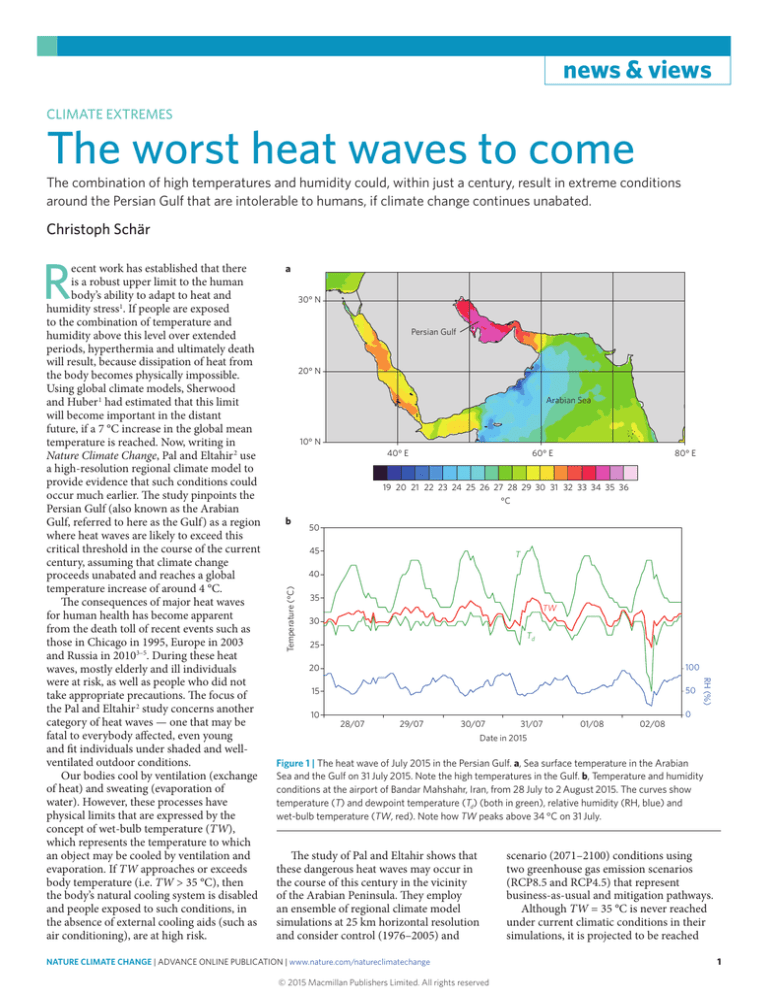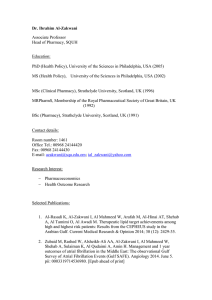
news & views
CLIMATE EXTREMES
The worst heat waves to come
The combination of high temperatures and humidity could, within just a century, result in extreme conditions
around the Persian Gulf that are intolerable to humans, if climate change continues unabated.
Christoph Schär
a
30° N
Persian Gulf
20° N
Arabian Sea
10° N
60° E
40° E
80° E
19 20 21 22 23 24 25 26 27 28 29 30 31 32 33 34 35 36
°C
b
50
45
T
40
Temperature (°C)
R
35
TW
30
Td
25
20
100
15
50
10
28/07
29/07
30/07
31/07
01/08
02/08
RH (%)
ecent work has established that there
is a robust upper limit to the human
body’s ability to adapt to heat and
humidity stress1. If people are exposed
to the combination of temperature and
humidity above this level over extended
periods, hyperthermia and ultimately death
will result, because dissipation of heat from
the body becomes physically impossible.
Using global climate models, Sherwood
and Huber 1 had estimated that this limit
will become important in the distant
future, if a 7 °C increase in the global mean
temperature is reached. Now, writing in
Nature Climate Change, Pal and Eltahir 2 use
a high-resolution regional climate model to
provide evidence that such conditions could
occur much earlier. The study pinpoints the
Persian Gulf (also known as the Arabian
Gulf, referred to here as the Gulf) as a region
where heat waves are likely to exceed this
critical threshold in the course of the current
century, assuming that climate change
proceeds unabated and reaches a global
temperature increase of around 4 °C.
The consequences of major heat waves
for human health has become apparent
from the death toll of recent events such as
those in Chicago in 1995, Europe in 2003
and Russia in 20103–5. During these heat
waves, mostly elderly and ill individuals
were at risk, as well as people who did not
take appropriate precautions. The focus of
the Pal and Eltahir 2 study concerns another
category of heat waves — one that may be
fatal to everybody affected, even young
and fit individuals under shaded and wellventilated outdoor conditions.
Our bodies cool by ventilation (exchange
of heat) and sweating (evaporation of
water). However, these processes have
physical limits that are expressed by the
concept of wet-bulb temperature (TW),
which represents the temperature to which
an object may be cooled by ventilation and
evaporation. If TW approaches or exceeds
body temperature (i.e. TW > 35 °C), then
the body’s natural cooling system is disabled
and people exposed to such conditions, in
the absence of external cooling aids (such as
air conditioning), are at high risk.
0
Date in 2015
Figure 1 | The heat wave of July 2015 in the Persian Gulf. a, Sea surface temperature in the Arabian
Sea and the Gulf on 31 July 2015. Note the high temperatures in the Gulf. b, Temperature and humidity
conditions at the airport of Bandar Mahshahr, Iran, from 28 July to 2 August 2015. The curves show
temperature (T) and dewpoint temperature (Td) (both in green), relative humidity (RH, blue) and
wet-bulb temperature (TW, red). Note how TW peaks above 34 °C on 31 July.
The study of Pal and Eltahir shows that
these dangerous heat waves may occur in
the course of this century in the vicinity
of the Arabian Peninsula. They employ
an ensemble of regional climate model
simulations at 25 km horizontal resolution
and consider control (1976–2005) and
NATURE CLIMATE CHANGE | ADVANCE ONLINE PUBLICATION | www.nature.com/natureclimatechange
© 2015 Macmillan Publishers Limited. All rights reserved
scenario (2071–2100) conditions using
two greenhouse gas emission scenarios
(RCP8.5 and RCP4.5) that represent
business-as-usual and mitigation pathways.
Although TW = 35 °C is never reached
under current climatic conditions in their
simulations, it is projected to be reached
1
news & views
several times in the business-as-usual
30-year scenario period in Bandar Mahshahr
and Bandar Abbas (Iran), Dhahran
(Saudia Arabia), Doha (Qatar), Dubai and
Abu Dhabi (United Arab Emirates), and
probably in additional locations along
the Gulf that have not been specifically
investigated. Furthermore, temperatures
are projected to reach unacceptable levels;
for instance, in some years of the scenario
period T = 60 °C will be exceeded in
Kuwait City. The rise in temperature and
humidity would thus be likely to constrain
development along the shores of the Gulf.
The study also shows that global mitigation
efforts consistent with the RCP4.5 scenario
would be of significant benefit in the
Gulf region.
Why is this effect so severe around the
Gulf (and to some lesser extent the Red Sea)?
This region is well known for its extremely
warm sea surface. These conditions owe
their existence to the shallow depth of the
Gulf, which implies that in response to
the seasonal cycle it warms much more
than the Arabian Sea (Fig.1a). There is also
evidence of a significant warming of the Gulf
during the past 60 years6, which was most
pronounced in the period 1990–2010 with
a trend of a 0.47 °C increase per decade.
Again, this warming was significantly larger
in the Gulf than in the Arabian Sea.
Although the control simulations
credibly represent the current climate,
and the authors provide a process-based
interpretation of their results, there are
some significant uncertainties. In particular,
the employed modelling framework uses
high computational resolution (25 km)
in the atmosphere, but future oceanic
conditions are taken from lower-resolution
2
global climate models. This simplification
may be justified due to the shallow
depth of the Gulf, but the results will
require corroboration using fully coupled
atmosphere–ocean models7.
There is also support for the study from
recent observations. Moist heat waves are
characteristic for the climatology of the
Gulf region, such as the dramatic event that
occurred towards the end of July 2015. In
terms of TW, it was one of the worst heat
waves ever recorded. Over much of the Gulf,
sea surface temperatures were above 34 °C
(Fig. 1a), and relative humidity was close
to saturation. To the north of the Gulf, dry
and hot desert conditions persisted, with
diurnal temperature variations peaking
at T = 48–51 °C in Basrah (Iraq) and
Omidiyeh (Iran). The worst of the heat wave,
however, developed in between the hot and
dry conditions over land, and the warm
and moist conditions over the Gulf, when
humid air was advected towards land with
southeasterly winds. Figure 1b shows surface
data from Bandar Mahshahr (Iran), about
30 km inland. For a whole week, maximum
daytime temperatures rose above T = 40 °C
and night temperatures stayed above 30 °C.
The worst, however, was the combination
of heat and humidity. The heat wave peaked
on 31 July around 12:00 ut (16:30 irdt)
with temperatures of T = 46 °C and a
relative humidity of 49%. These conditions
correspond to a wet-bulb temperature of
34.6 °C (red curve in Fig.1b), only slightly
below the critical TW threshold.
The occurrence of such an event lends
support to the results of Pal and Eltahir 2. If
TW can rise to above 34 °C in the current
climate, it is credible that it will sometimes
rise above 35 °C within this century, as
regional warming is projected to amount
to 2–3 °C with the RCP8.5 scenario8. The
new study thus shows that the threats to
human health may be much more severe
than previously thought, and may occur in
the current century. The study also indicates
that mitigation measures (reducing global
greenhouse gas emissions) and adaptation
efforts (protecting against heat waves) are
essential for the inhabitants of the Gulf and
Red Sea regions.
❐
Christoph Schär is at the Institute for Atmospheric
and Climate Science, Universitaetstrasse 16,
ETH Zurich, CH-8092 Zurich, Switzerland.
e-mail: schaer@env.ethz.ch
References
1. Sherwood, S. C. & Huber, B. Proc. Natl Acad. Sci. USA
107, 9552–9555 (2010).
2. Pal, J. & Eltahir, E. http://dx.doi.org/10.1038/nclimate2833 (2015).
3. Changnon, S. A., Kunkel, K. E. & Reinke, B. C.
Bull. Am. Meteor. Soc. 77, 1497–1506 (1996).
4. Robine, J.-M. et al. C. R. Biologies 331, 171–178 (2008).
5. Barriopedro, D., Fischer, E., Luterbacher, J., Trigo, R.
& Garcia-Herrera, R. Science 332, 220–224 (2011).
6. Shirvani, A., Nazemosadat, S. M. J. & Kahya, E. Arab. J. Geosci.
8, 2121–2130 (2015).
7. Xue, P. & Eltahir, E. A. B. J. Climate 28, 5041–5062 (2015).
8. Van Oldenborgh, G. J. et al. in Climate Change 2013: The Physical
Science Basis. (eds Stocker, T. F. et al.) Annex 1, 1311–1393
(IPCC, Cambridge Univ. Press, 2013).
Acknowledgements
Fig. 1a is based on the ECMWF analysis
(www.ecmwf.int) and was provided by Daniel Lüthi
(ETH Zurich). The meteorological surface data
analysed includes hourly data from a large number
of airports in the region. The author is indebted to
Ralph Rickli (Meteotest, Bern) for providing the
raw data for Fig. 1b and for professional support in
analysing the Iranian heat wave. Useful comments
from Erich Fischer, Niki Gruber and Jan Rajczak
(ETH Zurich) on an earlier version of this article
are also appreciated.
Published online: 26 October 2015
NATURE CLIMATE CHANGE | ADVANCE ONLINE PUBLICATION | www.nature.com/natureclimatechange
© 2015 Macmillan Publishers Limited. All rights reserved



